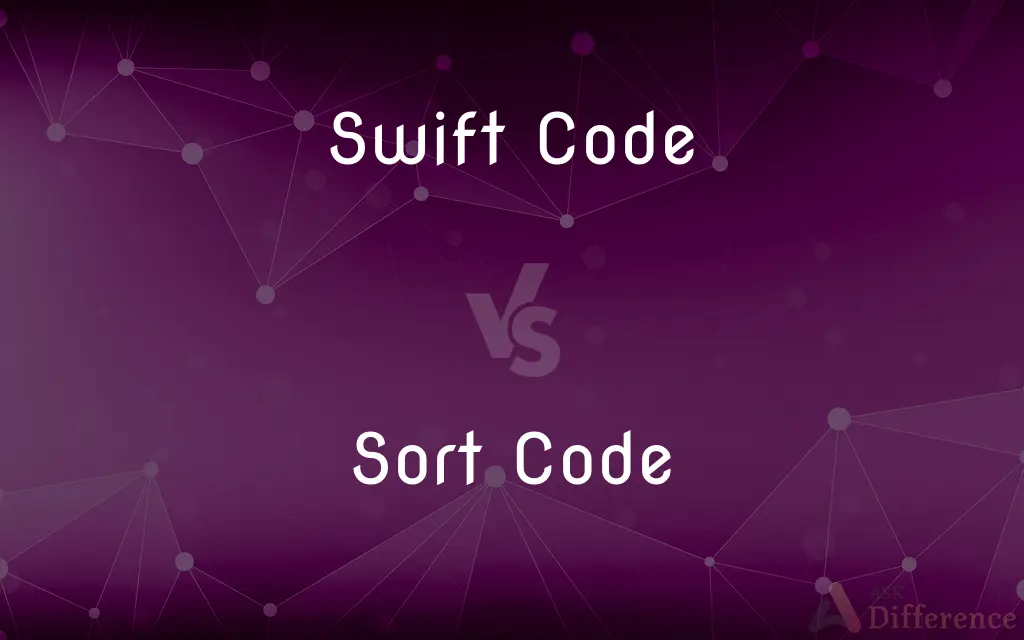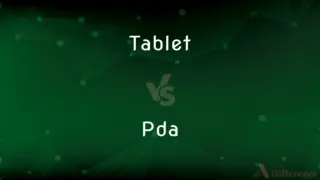Swift Code vs. Sort Code — What's the Difference?
By Tayyaba Rehman & Urooj Arif — Published on November 10, 2024
A SWIFT code is an international bank code that identifies particular banks worldwide, facilitating international wire transfers, while a sort code is a banking code used within the UK and Ireland to identify banks and branches for domestic transfers.

Difference Between Swift Code and Sort Code
Table of Contents
ADVERTISEMENT
Key Differences
SWIFT codes, also known as BIC (Bank Identifier Codes), are alphanumeric codes that consist of 8 to 11 characters. These codes are used globally to identify financial institutions in international transactions, supporting the automated processing of cross-border payments.
Sort codes, on the other hand, are a format of bank codes used primarily in the United Kingdom and Ireland, consisting of 6 digits formatted as 00-00-00, which identify both the bank and the specific branch where an account is held.
The primary function of a SWIFT code is to facilitate secure and swift international money transfers, enabling banks to send and receive information about financial transactions in a standardized environment. Sort codes, by contrast, are used to route money transfers between banks within the same country, specifically for tasks like setting up direct debits or making payments to someone else's account.
SWIFT codes are required for international transfers, where they ensure that the money reaches the correct bank and country through the international banking network. The structure of a SWIFT code breaks down into different sections that reveal information about the bank's name, country, location, and branch. Sort codes are crucial for the internal banking processes within the UK and Ireland, helping to streamline transactions and reduce the risk of errors in domestic money transfers.
One key difference is their geographic applicability: SWIFT codes have a global reach, necessary for international banking transactions, whereas sort codes are localized, playing a vital role in the domestic banking landscape of the UK and Ireland. This distinction reflects the broader role of SWIFT codes in the global financial system, compared to the more specific utility of sort codes in managing and organizing internal banking operations in certain countries.
ADVERTISEMENT
Both SWIFT and sort codes ensure the accurate and secure routing of financial transactions, but they operate on different scales and serve distinct purposes within the global banking infrastructure. While SWIFT codes connect financial institutions worldwide, sort codes provide a more focused approach to identifying banks and branches for domestic transactions within specific regions.
Comparison Chart
Purpose
Facilitate international bank transactions
Identify banks and branches for domestic transactions in the UK and Ireland
Format
8 to 11 alphanumeric characters
6 digits, formatted as XX-XX-XX
Geographic Use
International
UK and Ireland
Function
Identifies banks globally for secure international transfers
Routes money transfers between banks domestically
Required For
International wire transfers
Domestic payments and direct debits
Compare with Definitions
Swift Code
Includes bank, country, and branch information.
The SWIFT code CITIUS33 represents Citibank in the United States.
Sort Code
Used for internal transactions.
Setting up a direct debit requires the payee's sort code.
Swift Code
Used in the global banking network.
The SWIFT code is crucial for the accurate processing of international wire transfers.
Sort Code
Essential for local banking operations.
The sort code ensures quick domestic money transfers between banks.
Swift Code
It consists of 8 to 11 characters.
HSBC's SWIFT code, HSBCHKHHHKH, directs funds to their specific branch in Hong Kong.
Sort Code
Specific to the UK and Ireland.
Sort codes are a unique feature of the banking system in the UK and Ireland.
Swift Code
Necessary for cross-border payments.
Sending money to France requires the SWIFT code of the recipient's bank.
Sort Code
A sort code identifies UK and Ireland banks domestically.
The sort code 20-00-00 is used to identify a Barclays branch in London.
Swift Code
A SWIFT code identifies banks worldwide for international transactions.
The SWIFT code BARCGB22 ensures the money reaches Barclays Bank in the UK.
Sort Code
It is a 6-digit number.
Her account's sort code, 40-47-84, routes payments to the correct HSBC branch.
Common Curiosities
What is a sort code?
A sort code is a banking code used within the UK and Ireland to identify banks and branches for domestic transactions.
Why are SWIFT codes important for international transfers?
SWIFT codes ensure that international transfers are sent to the correct bank and branch, securing and speeding up cross-border payments.
How do I find a bank's SWIFT code?
A bank's SWIFT code can be found on its website, bank statements, or by contacting the bank directly.
Are sort codes unique to each bank branch?
Yes, sort codes are designed to uniquely identify bank branches for domestic transactions in the UK and Ireland.
Can SWIFT and sort codes be used interchangeably?
No, they serve different purposes: SWIFT codes are for international transfers, and sort codes are for domestic transactions within specific regions.
How often do SWIFT or sort codes change?
Changes are rare but can occur during bank mergers, acquisitions, or branch closures. It's important to use the most current code.
What is a SWIFT code?
A SWIFT code is an international banking code used to identify financial institutions worldwide for international wire transfers.
Can a sort code be used for international transfers?
No, sort codes are used for domestic transactions within the UK and Ireland; SWIFT codes are required for international transfers.
Is a SWIFT code the same for all branches of a bank?
Some banks have one SWIFT code for all branches, while others have different codes for each branch.
What happens if I use the wrong SWIFT or sort code?
Using the wrong code can lead to delays, extra charges, or the transfer being sent to the wrong account or bank.
Why do domestic transfers in the UK need a sort code?
Sort codes streamline the process of routing domestic transactions to the correct bank and branch, ensuring efficiency and accuracy.
Is it safe to share my SWIFT or sort code?
Yes, sharing your SWIFT or sort code is safe for receiving payments, but you should always ensure you're sharing it with trusted entities.
What is the difference in the structure of SWIFT codes and sort codes?
SWIFT codes are alphanumeric and range from 8 to 11 characters, indicating bank, country, and branch. Sort codes are numeric, 6 digits long, formatted as XX-XX-XX, identifying UK and Ireland banks and branches.
Do all banks use SWIFT codes?
Most banks involved in international transactions have SWIFT codes, but not all financial institutions may be part of the SWIFT network.
Can I use a sort code for transfers within other countries?
Sort codes are specific to the UK and Ireland; other countries have their own systems for domestic bank identification.
Share Your Discovery

Previous Comparison
Memory vs. Hard Disk
Next Comparison
Tablet vs. PdaAuthor Spotlight
Written by
Tayyaba RehmanTayyaba Rehman is a distinguished writer, currently serving as a primary contributor to askdifference.com. As a researcher in semantics and etymology, Tayyaba's passion for the complexity of languages and their distinctions has found a perfect home on the platform. Tayyaba delves into the intricacies of language, distinguishing between commonly confused words and phrases, thereby providing clarity for readers worldwide.
Co-written by
Urooj ArifUrooj is a skilled content writer at Ask Difference, known for her exceptional ability to simplify complex topics into engaging and informative content. With a passion for research and a flair for clear, concise writing, she consistently delivers articles that resonate with our diverse audience.














































